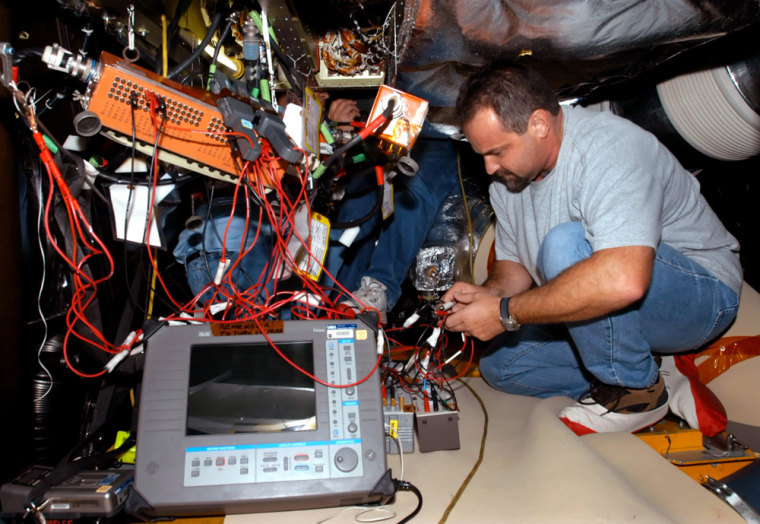NASA will continue troubleshooting a fuel-tank sensor glitch on the shuttle Discovery, then restart the countdown toward a launch on Tuesday, mission managers said Wednesday.
Engineers have not yet identified a clear-cut cause for the glitch, which cropped up intermittently a week ago and forced the postponement of the first shuttle mission since the loss of Columbia in February 2003. But they have detected potential problems with the electrical grounding of circuits associated with the troublesome sensor, said John Muratore, NASA's manager for shuttle systems engineering and integration.
Shuttle program manager Bill Parsons said the launch team would make some repairs immediately and conduct further tests by switching connections for the fuel-tank sensors. If all the components checked out as expected, NASA would then aim for liftoff at 10:39 a.m. ET Tuesday.
At one point, mission managers had considered conducting a tanking test first, but Parsons said the team would proceed directly toward launch instead.
"When we've done everything we can, and we've eliminated the most probable causes ... we believe the best way to do this is to do a countdown," Parsons told reporters at NASA's Kennedy Space Center in Florida.
If problems cropped up again during the countdown, the mission team would assess whether to make a fix or call off the launch again, Parsons said. Under some scenarios, the countdown might proceed even if the sensor glitch reappears.
The troublesome sensor is one of four low-level indicators in the liquid-hydrogen compartment of the fuel tank. Under NASA's current rules, all four of the sensors have to be working correctly in order for launch to proceed, but the system is designed to work even if two sensors fail.
Managers have been talking about drawing up an exception to the rule, to allow for the failure of one sensor before launch. "If we get a signature [to the sensor failure] that we understand, then we take an exception," Parsons said.
The sensor system signals the shuttle's computers to shut down the engines if the fuel tank is close to running dry. If the system doesn't work, the engines could shut down too soon — or keep running on empty, potentially damaging the propulsion system.
Discovery's 12-day mission is aimed at resupplying the international space station, as well as testing the safety procedures developed since the shuttle Columbia broke up during re-entry, killing all seven astronauts aboard. More than 100 cameras will be trained on Discovery at launch, looking for any sign of damage, and astronauts will test tools for inspecting and repairing the shuttle during flight.
The timing of the launch depends on the orbital position of the space station as well as the lighting conditions for liftoff and ascent.
In the past, NASA has said Discovery's current launch window would close July 31, with the next opportunity coming in September. However, managers are considering an extension of the current window a few days into August. Extending the launch window would mean giving up some of the imagery showing Discovery's external fuel tank as it comes off the orbiter.
An earlier version of this report misidentified the technician in the photograph of troubleshooting work on Discovery.
